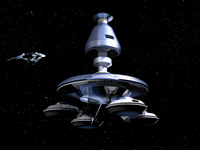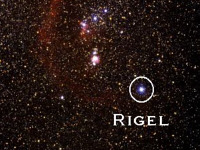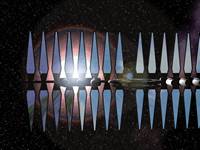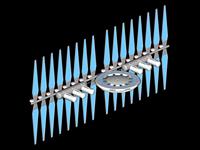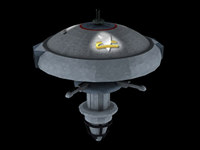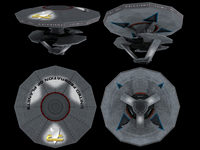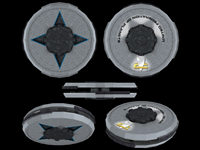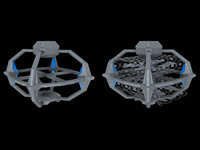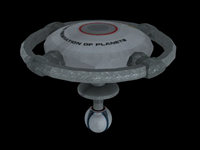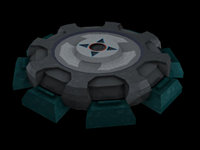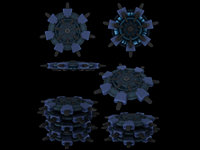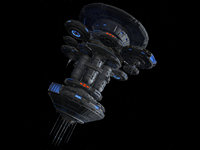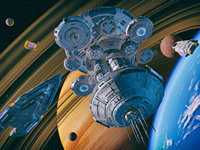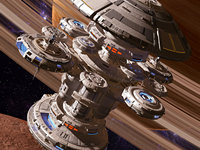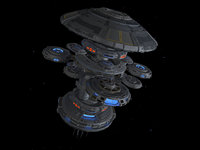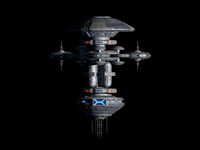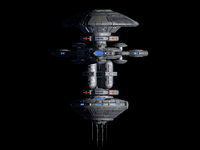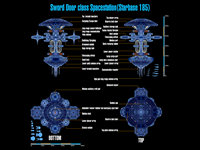NCX Type
Design by David Lovejoy
Diameter: 2.75km
Height: 4.5km
The NCX is a class of slightly smaller and more practical deep space stations built in the mid-2380s to serve as home bases for exploratory vessels on the Federation frontier. The station features four saucer-shaped docking modules capable of accommodating five small vessels each. An upper main docking facility allows capital ships to repair, refeul, or refit. Atop the main docking module is a command module, and in the center is the massive concourse module which is comprised of the power core, storage facilities for deuterium, dilithium, ordinance, parts, and other provisions, supplemented by a massive replication facility and a network of quarters for crew members and guests. These well-equipped bases, as well as new communication technology pioneered by the MIDAS array, extend the range of Starfleet, allowing for exploration of sectors thousands of light-years from Earth.
Rigel Iota Station
Design by Robert Heckadon
Type: Antimatter fuel refinery
Location: Orbiting at a distance of 6.5 billion km of the Beta Orion super giant, AKA Rigel
Commission date: 12:15 pm, July 22, 2381; Stardate 62970.1
Length: 358m
Width: 1250m
Height: 600m
Power sources: 32 photovoltaic collectors; 16 solar plasma converters; 2 M/ARC
At a distance of 800 light-years from Earth, located in the constellation of Orion, the Rigel Iota station is designed to collect vast quantities of solar energy and raw material from the blue super giant Beta Orion, also known as Rigel, and uses its energy to manufacture antimatter based fuel for starships, stations, and planets. The station orbits about 6.5 billion km around the star Rigel, close enough for maximum energy collection, yet far enough to prevent destruction of the station. Blue stars are preferred for energy production because the energy released by blue stars are generally greater than other stars.
The station starts by collecting expelled hydrogen gas from Rigel by the means of an array of hydrogen ramscoops. Once collected, the hydrogen is sent to a series of deuterium converters and antimatter generators to generate matter/antimatter fuel for starships, space stations, and planets. Deuterium converters are thermonuclear reactors that converts hydrogen into deuterium, which is a hydrogen isotope, without losing any real energy potential of the isotope. Later both the hydrogen and the deuterium are sent to the stations antimatter generators. These generators, similar to those found on a Galaxy-class starship, reversing the quantum charge of the deuterium and hydrogen into their antimatter counterparts.
However these generators are very energy expensive. In order to power an antimatter generator with thermonuclear reactors, 10 units of deuterium are needed to power the generator, and will convert only 1 unit of deuterium into anti-deuterium. In order to generate a Galaxy-class starships standard 3000 cubic metre supply of antimatter for example, 33000 cubic metres of deuterium are required, which is more than half of the 62500 cubic metres of a Galaxy class standard deuterium load. An alternative energy source is required.
Power for the stations refineries comes from both M/ARC, and solar energy. The station collects 2 types of solar energy from Rigel. 32 photovoltaic collector assemblies collect the light from the super giant and uses the power in the station's EPS grid. Within the stations 16 hydrogen ramscoops, are special generators that are designed to utilize the incredible amounts of energy within the expelled solar plasma from the sun as a power source. With the magnetic field of the ramscoops being many times larger than those on starships, the refinery can draw in incredible amounts of solar plasma energy. 2 M/ARC or matter/antimatter reaction chambers provides additional power should any of the solar energy collectors fail.
The station can manufacture enough antimatter to refuel a Galaxy-class starship in about 4 hours. This means that 2190 Galaxy-class starships can be filled with their normal 3 year antimatter supply in 1 year. Since the average Federation world only requires an energy equivalent to 3 kg of matter and antimatter a day, this station, and its sister stations, become indispensable for the future of the Federation.
References:
Star Trek: The Next Generation Technical Manual
Stardate Calculator: http://members.aol.com/kial976/page51.html
The Great Atlas of the Stars; by Serge Brunier
Star Trek Star Charts; by Geoffrey Mandel
Starbase Type 1 - Freestyle Class
Design by G.I.B.
Diameter: 4.8km
Height: 5.4km
No description
Starbase Type 2 - Trifertika Class
Design by G.I.B.
Diameter: 7.6km
Height: 4.4km
No description
Starbase Type 3
Design by G.I.B.
Diameter: 10.4km
Height: 2.6km
In battle mode, the starbase can "close" (the upper and lower part connect together), to protect everything (including the docked ships) inside.
This design was inspired by the Cylon base from "Battlestar Galactica".
Starbase Type 4
Design by G.I.B.
No specs available
This starbase may hold 4 Intrepids in each bay, 8 in total. Or 2 to 4 Galaxies in total.
Starbase Type 5 - Altero Class Variant 1
Design by G.I.B.
Diameter: 11.4km
Height: 8.4km
This base has 4 internal reapair/construction bays in the outer ring and 4 external docking bays in the lower mid section.
Starbase Type 6
Design by G.I.B.
Diameter: 9.5km
Height: 1.65km
This starbase can be built into SB3 and has the option to land on the starbase dock station on a planet.
Starbase Type 8
Design by G.I.B.
Diameter: 3.9km
Height: 0.6km (1.8km as a three-parter)
In case of emergency, the parts can disconnect from each other and become mobile and impulse capable.
Sword Door (Model 2617C) Class
Design by ncc21382(SC4525)
Type: Huge modular scalable space station
First commissioned: 2378
Length: 4202m
Width: 4925m
Height: 5845m
Decks:
Displacement: 132,453,000t
Complement: 3000 officers + 11000 crew, evacuation limit: 66000
Sublight speed: 0.00135c (max.)
Armament: 66 heavy phasers; 28 pair photon torpedo launchers
Embarked craft: 420 various shuttlecraft / fighters
UFP large starbase, fleet support centre or shipyard. 1 large dock, 2 medium docks, small dock, 2 large cargo ports, 6 medium ports, 36 shuttlebays.
See also: sc452598073.deviantart.com/

